nuggeteer
Jr. Member
- Joined
- Jun 7, 2013
- Messages
- 63
- Reaction score
- 134
- Golden Thread
- 0
- Location
- Redding, CA
- Detector(s) used
- Gold Bug Pro
- Primary Interest:
- Other
Hi everyone,
Headed out on my bike this week to four areas with good auriferous geology and many indications of mining. Lately, I've been spending time taking notes and making maps of all the information I'm gathering from various libraries and county departments. Having worked in both a library and bookstore I'm aware of the increasing popularity of e-readers, but there is a lot in old dusty books that will never be digitized or found on the internet.
Anyway, the first area was one of ground sluicings which I had detected before. I hiked up a bank of yellow metavolcanic bedrock that had scatters of red stained quartz and dark iron rich cobbles; the sort of scene where gold might make an appearance. It was also the scene of a pile of old junk which, of course, had been shot full of holes. I drifted over to the tailings, checking the troughs and slopes. A wide but shallow wash meandered down from a bank, and I focused my efforts there. Everything that ran off that bank came down to this wash and it was only two inches deep. Beneath the dust was a stretch of jagged bedrock to catch the heavy stuff. Unfortunately, it wasn't long before I realized that the only heavy stuff it caught was lead birdshot, and I got plenty. Toward the end of the day, I got tired of all the junk and moved up to the head of the wash which looked to be less affected by human activity. Within a few minutes, I had two small pieces of gold.
The second area was below steep hillsides that were mined in the late 1850's for gold-bearing quartz. I found this spot by following a ditch the old miners dug to bring water to their sluices. There was an escarpment above the ditches where the miners left off, and strips between the cuts that weren't sluiced. I detected these areas, but the gold must've been too deep or lacking thereof because I didn't find anything.
The third area was alongside a seasonal creek that had placers worked in the early 1850's. There were also several small claims along it as recently as the 1990's. A bald eagle was circling overhead when I arrived. The area looked really good, but much of it was situated under an old dump and after about an hour of my detector screaming at me I gave up. The bulk of the trash looked to be from the 1950's and I might go back just to dig through the heaps.
The fourth area was one I visited several months ago; before fully understanding how to use this detector. It was completely without trash as I had cleaned it thoroughly by digging up every single target. I remember my pockets being so full of rusted metal that the coil would pick up on it whenever I knelt down. The area was down slope from a large earthen dam and dry reservoir likely constructed for the operation of "booming." The ground sluicings were extensive but covered by manzanita to such a point that only a small portion was open to detecting. As I swung away, I continuously kicked off the veneer of pine needles and rounded cobbles to expose the clay layer beneath. In the process, I uncovered a thick line of huge red ants which immediately began ascending my legs. Luckily, only one made it above my socks to bite. Not long afterward, I began getting the signals I had missed before and at the end of the day I had four more pieces of gold, one being the largest I've ever found.
Below: the first area and the gold, the second area, the third area, the bald eagle, the fourth area and the gold, the gold
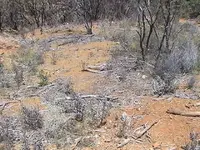
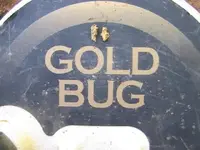
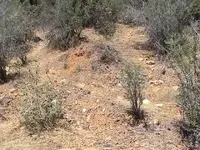
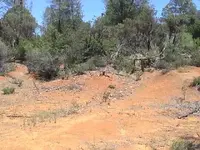
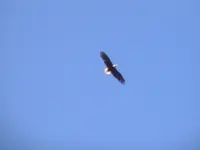
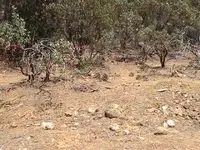
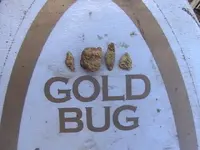
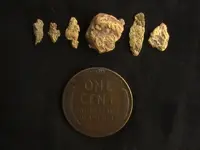
Headed out on my bike this week to four areas with good auriferous geology and many indications of mining. Lately, I've been spending time taking notes and making maps of all the information I'm gathering from various libraries and county departments. Having worked in both a library and bookstore I'm aware of the increasing popularity of e-readers, but there is a lot in old dusty books that will never be digitized or found on the internet.
Anyway, the first area was one of ground sluicings which I had detected before. I hiked up a bank of yellow metavolcanic bedrock that had scatters of red stained quartz and dark iron rich cobbles; the sort of scene where gold might make an appearance. It was also the scene of a pile of old junk which, of course, had been shot full of holes. I drifted over to the tailings, checking the troughs and slopes. A wide but shallow wash meandered down from a bank, and I focused my efforts there. Everything that ran off that bank came down to this wash and it was only two inches deep. Beneath the dust was a stretch of jagged bedrock to catch the heavy stuff. Unfortunately, it wasn't long before I realized that the only heavy stuff it caught was lead birdshot, and I got plenty. Toward the end of the day, I got tired of all the junk and moved up to the head of the wash which looked to be less affected by human activity. Within a few minutes, I had two small pieces of gold.
The second area was below steep hillsides that were mined in the late 1850's for gold-bearing quartz. I found this spot by following a ditch the old miners dug to bring water to their sluices. There was an escarpment above the ditches where the miners left off, and strips between the cuts that weren't sluiced. I detected these areas, but the gold must've been too deep or lacking thereof because I didn't find anything.
The third area was alongside a seasonal creek that had placers worked in the early 1850's. There were also several small claims along it as recently as the 1990's. A bald eagle was circling overhead when I arrived. The area looked really good, but much of it was situated under an old dump and after about an hour of my detector screaming at me I gave up. The bulk of the trash looked to be from the 1950's and I might go back just to dig through the heaps.
The fourth area was one I visited several months ago; before fully understanding how to use this detector. It was completely without trash as I had cleaned it thoroughly by digging up every single target. I remember my pockets being so full of rusted metal that the coil would pick up on it whenever I knelt down. The area was down slope from a large earthen dam and dry reservoir likely constructed for the operation of "booming." The ground sluicings were extensive but covered by manzanita to such a point that only a small portion was open to detecting. As I swung away, I continuously kicked off the veneer of pine needles and rounded cobbles to expose the clay layer beneath. In the process, I uncovered a thick line of huge red ants which immediately began ascending my legs. Luckily, only one made it above my socks to bite. Not long afterward, I began getting the signals I had missed before and at the end of the day I had four more pieces of gold, one being the largest I've ever found.
Below: the first area and the gold, the second area, the third area, the bald eagle, the fourth area and the gold, the gold








Amazon Forum Fav 👍
Upvote
0






